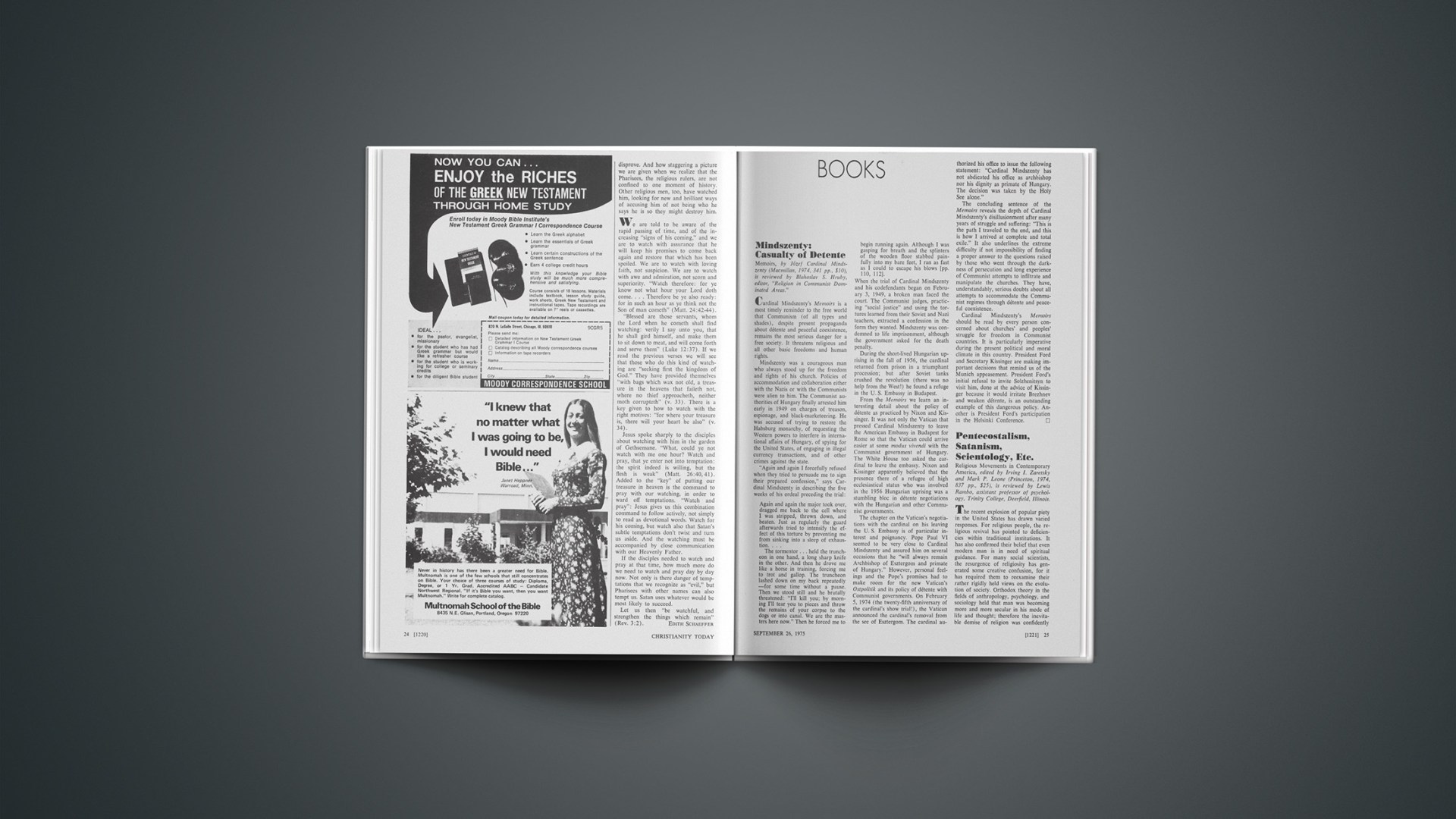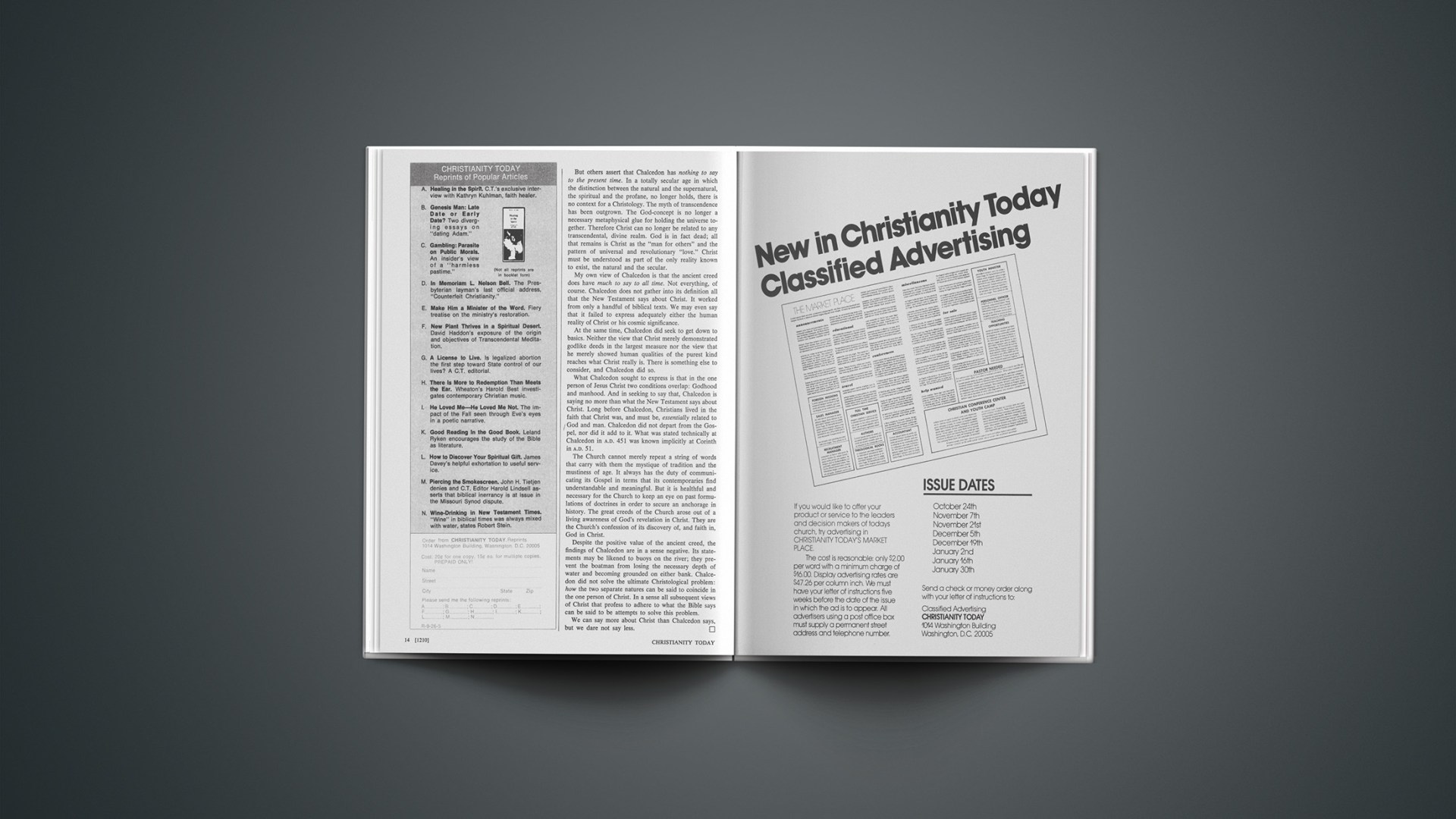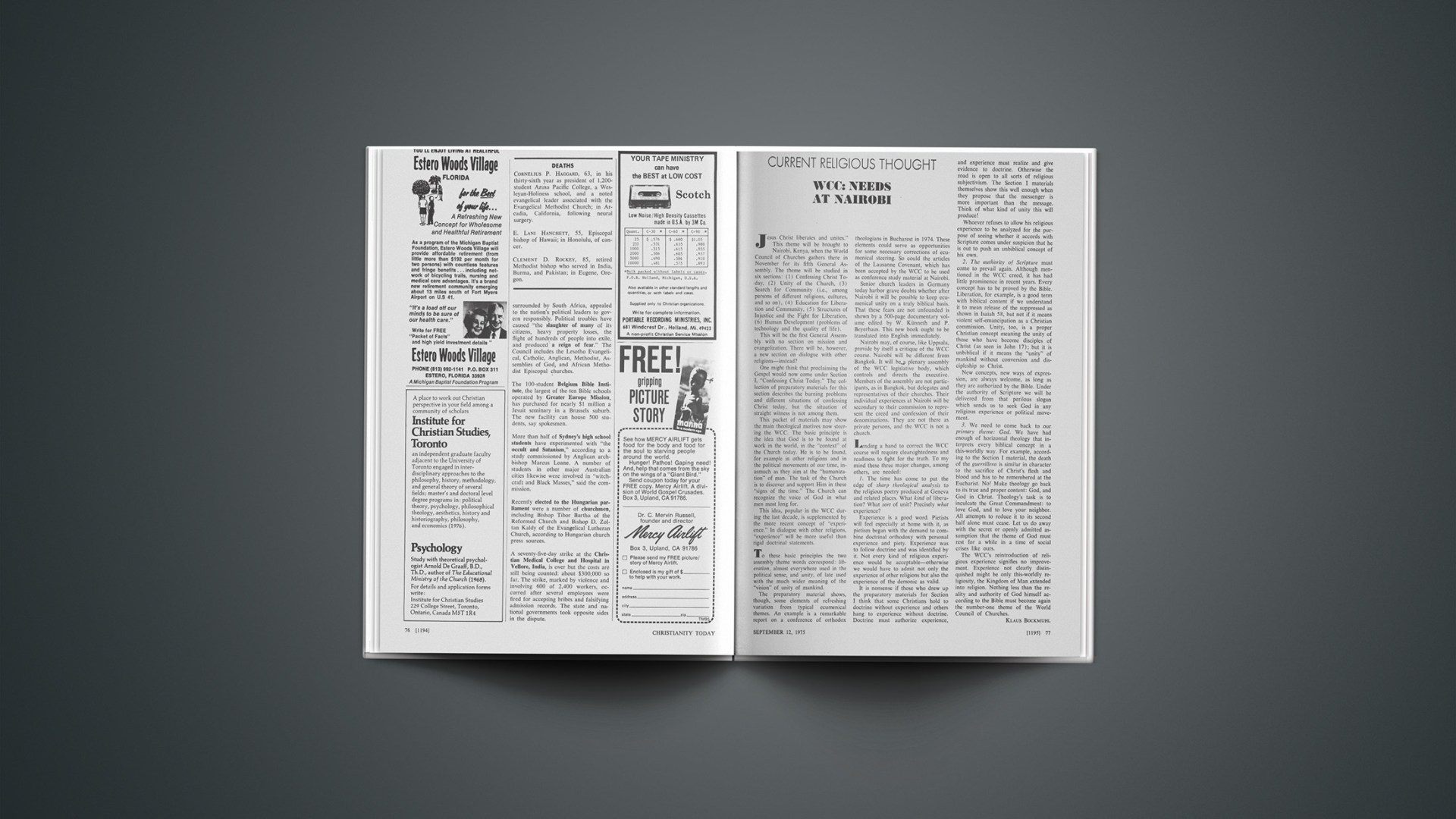Mindszenty: Casualty Of Detente
Memoirs, by Józef Cardinal Mindszenty (Macmillan, 1974, 341 pp., $10), is reviewed by Blahoslav S. Hruby, editor, “Religion in Communist Dominated Areas.”
Cardinal Mindszenty’s Memoirs is a most timely reminder to the free world that Communism (of all types and shades), despite present propaganda about detente and peaceful coexistence, remains the most serious danger for a free society. It threatens religious and all other basic freedoms and human rights.
Mindszenty was a courageous man who always stood up for the freedom and rights of his church. Policies of accommodation and collaboration either with the Nazis or with the Communists were alien to him. The Communist authorities of Hungary finally arrested him early in 1949 on charges of treason, espionage, and black-marketeering. He was accused of trying to restore the Habsburg monarchy, of requesting the Western powers to interfere in international affairs of Hungary, of spying for the United States, of engaging in illegal currency transactions, and of other crimes against the state.
“Again and again I forcefully refused when they tried to persuade me to sign their prepared confession,” says Cardinal Mindszenty in describing the five weeks of his ordeal preceding the trial:
Again and again the major took over, dragged me back to the cell where I was stripped, thrown down, and beaten. Just as regularly the guard afterwards tried to intensify the effect of this torture by preventing me from sinking into a sleep of exhaustion.…
The tormentor … held the truncheon in one hand, a long sharp knife in the other. And then he drove me like a horse in training, forcing me to trot and gallop. The truncheon lashed down on my back repeatedly—for some time without a pause. Then we stood still and he brutally threatened: “I’ll kill you; by morning I’ll tear you to pieces and throw the remains of your corpse to the dogs or into canal. We are the masters here now.” Then he forced me to begin running again. Although I was gasping for breath and the splinters of the wooden floor stabbed painfully into my bare feet, I ran as fast as I could to escape his blows [pp. 110, 112].
When the trial of Cardinal Mindszenty and his codefendants began on February 3, 1949, a broken man faced the court. The Communist judges, practicing “social justice” and using the tortures learned from their Soviet and Nazi teachers, extracted a confession in the form they wanted. Mindszenty was condemned to life imprisonment, although the government asked for the death penalty.
During the short-lived Hungarian uprising in the fall of 1956, the cardinal returned from prison in a triumphant procession; but after Soviet tanks crushed the revolution (there was no help from the West!) he found a refuge in the U. S. Embassy in Budapest.
From the Memoirs we learn an interesting detail about the policy of detente as practiced by Nixon and Kissinger. It was not only the Vatican that pressed Cardinal Mindszenty to leave the American Embassy in Budapest for Rome so that the Vatican could arrive easier at some modus vivendi with the Communist government of Hungary. The White House too asked the cardinal to leave the embassy. Nixon and Kissinger apparently believed that the presence there of a refugee of high ecclesiastical status who was involved in the 1956 Hungarian uprising was a stumbling bloc in détente negotiations with the Hungarian and other Communist governments.
The chapter on the Vatican’s negotiations with the cardinal on his leaving the U. S. Embassy is of particular interest and poignancy. Pope Paul VI seemed to be very close to Cardinal Mindszenty and assured him on several occasions that he “will always remain Archbishop of Esztergom and primate of Hungary.” However, personal feelings and the Pope’s promises had to make room for the new Vatican’s Ostpolitik and its policy of détente with Communist governments. On February 5, 1974 (the twenty-fifth anniversary of the cardinal’s show trial!), the Vatican announced the cardinal’s removal from the see of Esztergom. The cardinal authorized his office to issue the following statement: “Cardinal Mindszenty has not abdicated his office as archbishop nor his dignity as primate of Hungary. The decision was taken by the Holy See alone.”
The concluding sentence of the Memoirs reveals the depth of Cardinal Mindszenty’s disillusionment after many years of struggle and suffering: “This is the path I traveled to the end, and this is how I arrived at complete and total exile.” It also underlines the extreme difficulty if not impossibility of finding a proper answer to the questions raised by those who went through the darkness of persecution and long experience of Communist attempts to infiltrate and manipulate the churches. They have, understandably, serious doubts about all attempts to accommodate the Communist regimes through détente and peaceful coexistence.
Cardinal Mindszenty’s Memoirs should be read by every person concerned about churches’ and peoples’ struggle for freedom in Communist countries. It is particularly imperative during the present political and moral climate in this country. President Ford and Secretary Kissinger are making important decisions that remind us of the Munich appeasement. President Ford’s initial refusal to invite Solzhenitsyn to visit him, done at the advice of Kissinger because it would irritate Brezhnev and weaken detente, is an outstanding example of this dangerous policy. Another is President Ford’s participation in the Helsinki Conference.
Pentecostalism, Satanism, Scientology, Etc.
Religious Movements in Contemporary America, edited by Irving I. Zaretsky and Mark P. Leone (Princeton, 1974, 837 pp., $25), is reviewed by Lewis Rambo, assistant professor of psychology, Trinity College, Deerfield, Illinois.
The recent explosion of popular piety in the United States has drawn varied responses. For religious people, the religious revival has pointed to deficiencies within traditional institutions. It has also confirmed their belief that even modern man is in need of spiritual guidance. For many social scientists, the resurgence of religiosity has generated some creative confusion, for it has required them to reexamine their rather rigidly held views on the evolution of society. Orthodox theory in the fields of anthropology, psychology, and sociology held that man was becoming more and more secular in his mode of life and thought; therefore the inevitable demise of religion was confidently predicted. Furthermore, the researcher generally viewed religion as the reflection or residue of the larger processes of culture, society, and personality.
Religious Movements in Contemporary America consists of twenty-seven essays that seek to sketch the contours of the current religious renaissance and to reformulate a theory of religion. The book is a major achievement on both counts. First, it gives extensive reports on field research conducted among such groups as the Hare Krishna movement, Scientology, Satanists, Pentecostals, Mormons, and many others. As participant observers, the authors offer us detailed, and empathetic accounts.
Theoretically, too, the book is important, for it levels major criticisms against the dominant views of religion: that it is (a) a reaction to some form of deprivation (whether social, psychological, or economic) or (b) a response to the general disorganization of the larger society in which it lives. In my opinion, the book’s only fault is that there are only tentative attempts to construct a new, more comprehensive theory of religion. Nevertheless, the criticism of the reigning theories and the explorations into new territory are extremely valuable.
Generally, one who reviews so large a book written by so many different people feels constrained to report that the contents vary greatly in quality. That statement is not necessary for this book. The reader’s own evaluation of each essay will be determined more by his interests—whether they lie in theory or data, the occult or the more traditional—than by the quality of writing (which is unusually high) or by the author’s theoretical bias. The only problem confronting the reviewer is selection. One cannot comment on all the articles. My choice of several reflects my psychological orientation, my concern for the integrative and innovative dimensions of religious experience, and my liking for theoretical questions.
“Ideological support for the Marginal Middle Class: Faith Healing and Glossolalia” by E. Mansell Pattison skillfully portrays the personality style of the ardent fundamentalist. Pattison says that fundamentalists tend to be riddled with conflicts—covertly hostile and overtly passive, acutely aware of their worthlessness and stubbornly arrogant—and oriented to the future. Pattison also clearly lays down a theory for the relation between personality characteristics and the cultural milieus that foster certain styles.
Virginia H. Hine in “The Deprivation and Disorganization Theories of Social Movements” astutely analyzes contemporary theories of religion. Her essay explicitly states what is implicit throughout the book, that current theories cannot provide a coherent understanding of religious phenomenon. E. Fuller Torrey’s “Spiritualists and Shamans as Psychotherapists” is a direct attack on the condescending attitude of many American social scientists toward the healers of different societies; they assume, by definition, that psychiatry and clinical psychology is superior because it is more “scientific.” Healing, according to Torrey, is a process that combines art and science, even for the successful therapist in the United States. Torrey’s colleagues who react only with dismay to what he says will probably miss some valuable insights.
One of the most surprising essays is Edward J. Moody’s “Magical Therapy: An Anthropological Investigation of Contemporary Satanism.” The article is rich in details of the inner workings of a California Satanist group. It is startling to discover that (at least in Moody’s perception of the situation) Satanism’s bizarre rituals and its violently anti-Christian stance do, in fact, “socialize” its adherents and make them more “normal.” Those drawn to Satanism are deficient in the skills necessary to lead successful lives in society. Their failure breeds anger toward society. However, through their association with Satanist groups, these people are taught to perceive social expectations more correctly. This helps them achieve personal success in business, family, and other areas. The carefully controlled (and secret) rituals of Satanism are useful to diffuse hostility and create an environment in which personal relations are structured and gradually transformed. Moody’s study is arresting and useful in that he disabuses us of stereotypes of Satanism; however, his analysis of the movement tends toward advocacy at times. Satanism is “therapeutic” for some; yet most people would probably feel that the cure is worse than the disease.
The editors of the book are to be praised for their excellent organization. Diverse subjects are given compelling coherence. The editor’s extensive introductions give invaluable orientation to the essays, and they point to salient issues and problems raised in various sections of the book. The fascinating details, the openness to the novel qualities of these groups, and the willingness to attempt new theoretical formulations make this book a refreshing harbinger of a new approach to religion among social scientists.
BRIEFLY NOTED
Keeping Your Cool in a World of Tension, by Richard LeTourneau (Zondervan, 142 pp., $4.95), Life Is So Great, I Really Don’t Want to Get Off, by Milo Arnold (Zondervan, 200 pp., $5.95), Living With Depression and Winning, by Sarah Fraser (Tyndale, 110 pp., $1.45 pb), Survival Kit For the Stranded, by William Self (Broadman, 142 pp., $4.95), and That Elusive Thing Called Joy, by Calvin Miller (Zondervan, 144 pp., $4.95). Five books by evangelicals that seek to help Christians deal with the tensions and problems of modern living. LeTourneau in outline format uses the concepts of dynamics and diligence to discuss the Christian life in general. Arnold’s theme is fulfillment. He uses a kind of Christian “positive thinking” approach. Fraser writes perceptively of her struggle with suicidal depression. Self’s book encompasses many mental-spiritual crises such as mental illness, grief, guilt, fear, despair, loneliness, and illness. Well written. Miller structures his book around a pattern he calls a “happiness construct.” This formula approach to life could be very dry, but Miller’s good ideas about human relationships add spice to the recipe.
God’s Party, by David Randolph (Abingdon, 144 pp., $3.50 pb), and A New Look For Sunday Morning, by William Abernathy (Abingdon, 176 pp., $4.50 pb). Two volumes that focus on changes from the more traditional forms of worship. Randolph explains why change is sometimes needed and offers some suggestions for innovative worship. Abernathy records the experiences of his Congregational church in Connecticut. Neither author is so extreme that evangelicals cannot benefit from what he relates.
A Father … A Son … And a Three-Mile Run, by Keith Leenhouts (Zondervan, 140 pp., $4.95). A poignant story of a special father-son relationship. The father/author brings his insights as a Christian and a judge to his observations of fatherhood.
Property and Riches in the Early Church, by Martin Hengel (Fortress, 96 pp., $2.95 pb). Examines the attitudes toward owning things expressed in the Old Testament, in the New Testament by Jesus and Paul, and in the early centuries of the Church. Not definitive, but a well researched, thoughtful exposition.
Jesus in Genesis, by Michael Esses (Logos, 270 pp., $2.95 pb), Judges and a Permissive Society, by John Hunter (Zondervan, 128 pp., n.p., pb), and Hosea and His Message, by Roy L. Honeycutt (Broadman, 96 pp., $1.50 pb). Somewhat unusual approaches to three Old Testament books. Esses attempts to relate Genesis directly to the teachings of Jesus; he writes in a light style that some will find hollow. Hunter studies Judges through the characters in the book. A help, especially for a beginning student of the Old Testament. Honeycutt expounds on a somewhat unfamiliar book chapter by chapter in a simple, readable style. He draws some good parallels with modern times.
The Transfiguration of Politics, by Paul Lehmann (Harper & Row, 366 pp., $12.95). A ponderous, self-assured tome by a leading ethicist. Advanced students of the relations between Christ and government and political change cannot ignore this book, though many will argue with it.
God and the Future, by Henry McKeating (Judson, 94 pp., $3.50), Jesus the King Is Coming, edited by Charles Feinberg (Moody, 200 pp., $4.95), The Approaching Advent of Christ, by Alexander Reese (Grand Rapids International [P.O. Box 2607, Grand Rapids, Mich. 49501], 328 pp., $5.95), What, Where, and When Is the Millennium?, by R. Bradley Jones (Baker, 144 pp., $2.95 pb), and The Dawn of the Apocalyptic, by Paul Hanson (Fortress, 428 pp., $14.95). Eschatology is the area of doctrine with the most books. McKeating writes on the whole biblical approach to the future, not just the end. Feinberg’s contributors include such notables as Hal Lindsey and John Walvoord. A good introduction to one widespread view. Price concentrates on prophetic fulfillment relating to restoration of Israel and Jewish expectations of the Messiah, especially as they affect the Christian. Reese’s volume, a reprint, is a polemical, often quoted defense of a post-tribulational view of the Second Coming. Jones contends that the millennium is now; his views will interest the prophecy buff. Hanson gives a scholarly treatment of the origins of apocalyptic writings, for the advanced student.
Believe!, by Richard DeVos (Revell, 128 pp., $4.95), and Success, Motivation and the Scriptures, by William Cook (Broadman, 172 pp., $3.95). What is the relation between “success” and the Christian faith? DeVos, president of Amway, seems to be saying that belief in God, America, and free enterprise is the key to a successful life. Some may question his thesis. Cook attempts to apply biblical principles to the subject and brings more depth to the understanding of motivation.
Scripture And Sciences: Concord, Not Conflict
The Clock Work Image, by Donald MacKay (InterVarsity, 1974, 112 pp., $2.25 pb), is reviewed by Michael Macdonald, associate professor of German and philosophy, Seattle Pacific College, Seattle, Washington.
Donald MacKay, a professor of communications and a specialist in brain physiology, is the author of Room For Freedom and Action in a Mechanistic Universe. He has debated B. F. Skinner on William Buckley’s TV show, “Firing Line.” As a scientist and a Christian, MacKay here examines the Christian view of the universe and its relation to scientific thought.
His theme is the essential, non-accidental harmony between biblical Christian faith and mechanistic science. MacKay emphasizes a philosophy of wholeness: the harmony and complementarity between Christian thought on the one hand and the spirit and practice of natural science on the other. God’s story is revealed in both Scripture and science, and MacKay thinks that the greatest educational need of our time is to restore wholeness to our view of life.
We tend to try to understand each situation by analogy with a machine. Much can be described and analyzed as a mechanism, but this does not mean that the only “real,” objective, worthwhile explanations are the explanations we get from machine analogies. We can know some aspects of reality only by becoming involved with them. MacKay argues that if you transfer scientific criteria, which are expressly developed for observing physical objects, into the sphere of religion, which deals with the personal knowledge of God, “you do not discover a conflict, you create one.” He maintains “that the religious and the scientific approaches are not rivals but are complementary, each appropriate to an aspect of experience largely ignored by the other.”
The scientist has no reason to deny that there is much knowledge of a different kind to be gained by personal involvement. In many situations one should become a participant and accept personal responsibility. The move is one from detachment to involvement. This extremely important distinction is reminiscent of Bergson, Buber, and more recently Tournier. Each in his own way stresses that there are two profoundly different ways of knowing—one by moving around the object, which depends on point of view, and another by entering into a personal relationship with it.
Provocative and sensitive, this book is written both for Christians who want to evaluate science in the light of their faith and for non-Christians who wish to discover what commitment to Christ would do to their intellectual integrity in this age of mechanistic science. The book is based largely on talks given over the past twenty years; some presupposed no religious commitment, while others were given at conferences of Christians. The slight unevenness in style is understandable and not bothersome.












